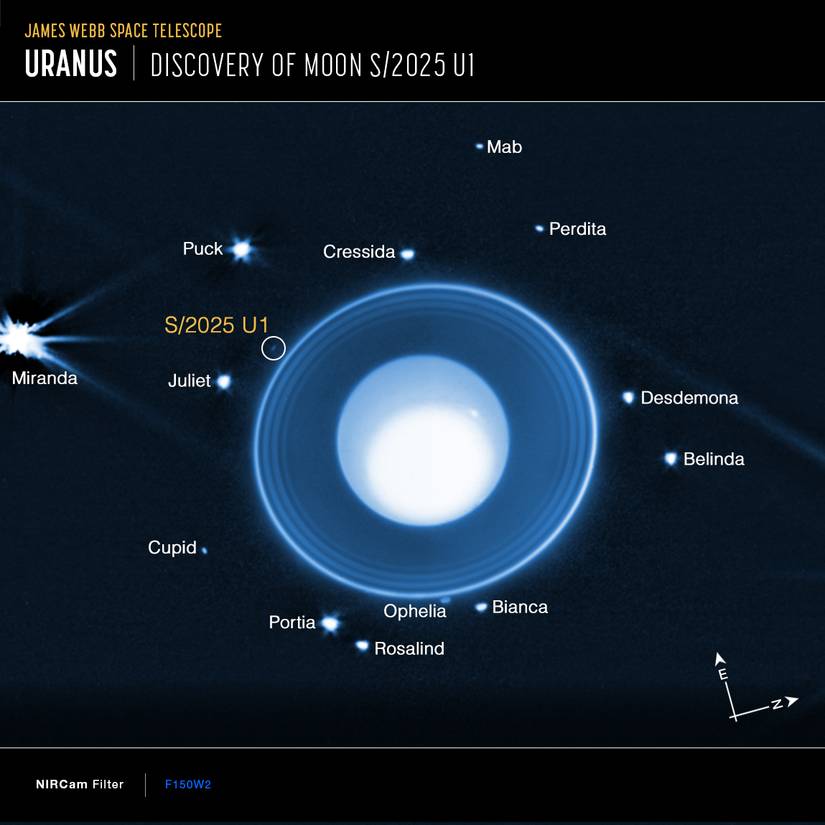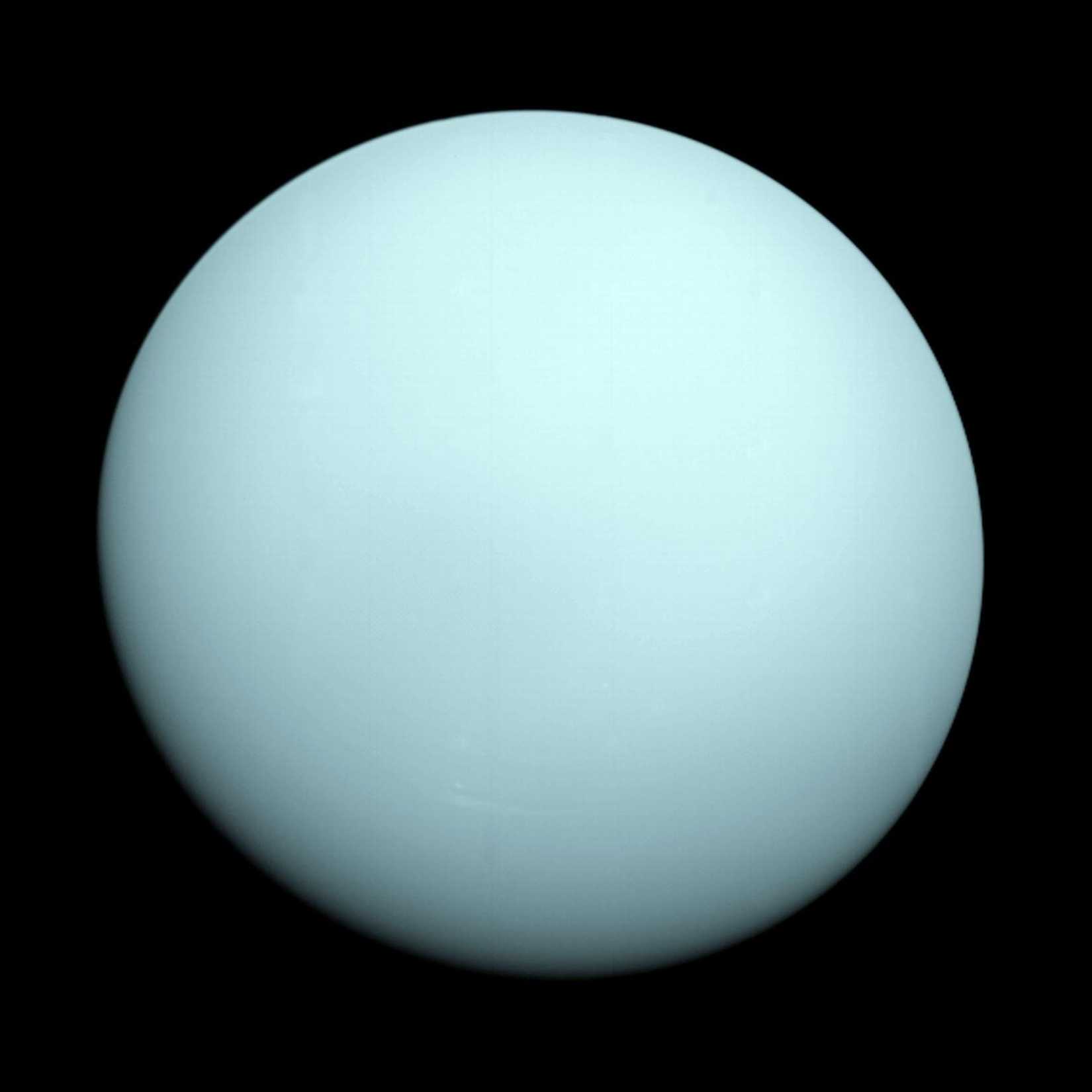Astronomers using NASA’s James Webb Space Telescope have discovered a tiny new moon orbiting Uranus, a rare discovery that expands Uranus’ total known moons to 29, and the first inner one found in nearly 40 years. Provisionally named S/2025 U1, the hidden moon was first detected on February 2, 2025, and at just 10 kilometers (six miles) wide it is the smallest inner moon yet found around Uranus.
Although the discovery was made months ago, the 29th known moon of Uranus was only just officially announced. To learn more I reached out to Dr. Matthew Tiscareno, a planetary scientist at the SETI Institute in Mountain View, California, who explained, “It takes time to do careful analysis and be very sure of such a momentous announcement.”
I also connected with Matthew M. Hedman from University of Idaho who worked directly on these Webb observations. He explained to me that Webb was being used to gather images partly with this kind of discovery in mind. “They used wide filters and long exposure times that were good for seeing the faint signals from small moons,” he said. Confirming the object, however, required months of processing and analysis.
The Smallest Inner Moon Found Yet For Uranus
That relatively tiny size explains why the Voyager 2 probe completely missed it during its 1986 flyby of the sideways planet, despite having “returned more than 7,000 photographs, revealing 11 new moons, the innermost ones being intricately involved with the ring system, and two new rings orbiting the planet,” writes NASA historian John Uri.
Voyagers 1 and 2, both launched in 1977 on a mission to explore Jupiter and Saturn, and thanks to a rare planetary alignment that occurs once every 175 years, Voyager 2 was able to continue on a trajectory for years to fly past Uranus.
Hedman added that the new moon was beyond Voyager’s reach. “This object was simply too faint to be seen in most of the images Voyager 2 took of the Uranus system,” he explained. “Voyager 2 needed to survey the entire Uranus system during its brief flyby, and the exposures were not long enough to detect this object.”
It’s not just the size that kept this moon hidden though, but also its positioning. “JWST is such an amazingly sensitive camera that it actually can see more than Voyager could see, despite the much greater distance,” Matthew Tiscareno tells me. “JWST can see the entire Uranus system at once, while a spacecraft in the middle of the system can only look in one direction at a time.”
Where Is This New Moon And Are There More To Be Found?
“It’s located about 35,000 miles (56,000 kilometers) from Uranus’ center, orbiting the planet’s equatorial plane between the orbits of Ophelia (which is just outside of Uranus’ main ring system) and Bianca,” said Maryame El Moutamid, the lead on this latest Webb observing program studying the rings and moons of Uranus, said of her discovery. “Its nearly circular orbit suggests it may have formed near its current location.” Tiscareno adds:
“The inner moons of Uranus are a complex and chaotic system. They probably go back and forth between a ring state and a moon state. Examining the orbit of this moon will give us additional insight into that dynamic, like finding one more piece of a jigsaw puzzle.”
Hedman tells me that Uranus’ small moons are packed so closely together that their orbits can get messy over time, making the system unstable. “The larger number of small moons orbiting outside the rings in a relatively small region gives rise to complex interactions among the moons,” he said. “These can lead to chaotic perturbations and even collisions among the moons on time scales of 1 to 100 million years.”
For Tiscareno, the most exciting part may be what this discovery implies: there could be more moons still hidden around Uranus. “This is by far the smallest and faintest of the inner moons we’ve discovered, and usually smaller things are more numerous,” he said.
This is probably the first among others.
While the program’s data has yet to undergo the peer-review process, like all Uranus moons, S/2025 U1 will eventually receive a permanent and more fun name, and instead of drawing inspiration from Greek and Roman gods, Uranus’ moons are uniquely named after characters from Shakespeare and Alexander Pope.
Why Uranus Is Such A Unique Planet
With names like Titania, Oberon, Ariel, and Juliet already in use, S/2025 U1 will join an unusually literary celestial family. I asked Tiscareno if he had any ideas in mind but he says they “can’t talk about any suggestions that have been made until the IAU approves them,” and Hedman confirms that the “team are discussing exactly this at the moment.”
The International Astronomical Union (IAU), founded over a century ago, is responsible for officially naming astronomical objects.
In addition to its unique moon naming convention, Uranus itself is one of the solar system’s strangest worlds. The ice giant spins on its side with a tilt of nearly 98 degrees, likely the result of a massive collision long ago with an Earth-sized object, according to NASA. This extreme orientation creates the most bizarre seasons in the solar system, with each pole experiencing 21 years of continuous sunlight followed by 21 years of darkness.
Some studies suggest Uranus was knocked sideways by one or more giant impacts, which may also explain why its moons and rings orbit along the tilted equator. Research by Alessandro Morbidelli of the Observatory of Côte d’Azur in 2011 proposed two back-to-back collisions, while a 2017 study by Kyoto University’s Yuya Ishizawa suggested debris from such an impact may have helped create the planet’s unusually small moons.
Uranus features 13 rings and more small inner moons than any other planet, blurring the line between where rings end and moons begin. Nearly four decades after Voyager 2 provided the only close-up look at Uranus, Webb is showing that the sideways planet still holds surprises waiting to be uncovered.
“We are continuing to process the images in order to better determine its orbit and its color, both of which will help us to better understand its place within the Uranus system,” Hedman said.
Tiscareno added, “We want to continue to study its orbit, which will require more observing time from JWST. Only with additional observations can we really unlock what this moon may have to tell us about its history and surroundings in the Uranus system.”
Images courtesy of NASA, ESA, CSA, STScI, and JPL-Caltech.
Source link





